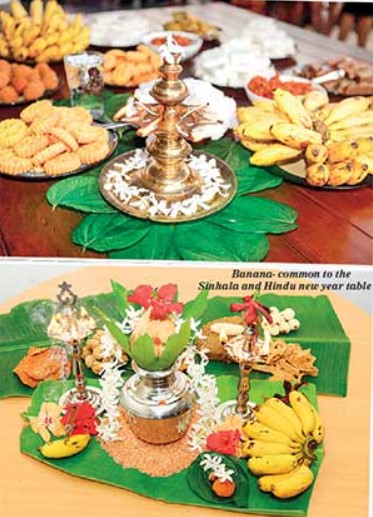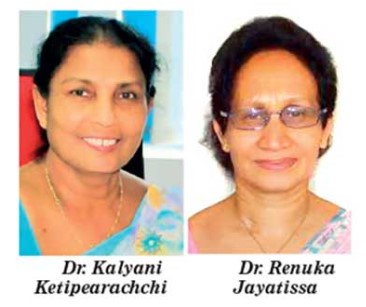
Source:Island
Be it visiting loved ones for the new year or on any other occasion, taking a comb of bananas along is a time-honoured practice among Lankans. We are not alone in our love for this delectable fruit relished over centuries by mankind and herbivorous animals alike. One of the most widely grown fruit crops in the world, banana occupies a top place in the fresh fruit trade, second only to orange. Banana (Musa spp.) is native to South Asia and Western Pacific Region. The wild ancestors of cultivated banana Musa acuminate Colla and Musa balbisiana Colla are distributed in South and South East Asian countries including Sri Lanka.
 The earliest written reference to bananas in Sri Lankan history goes back to about 341 A.D. the time of King Buddhadasa who is reputed to have been a skilled physician. The king had recorded in his Sarartha Sangragaha, the medicinal values of various parts of the banana plant. There is also evidence that the prehistoric inhabitants of the island, over 12,000 years ago had eaten wild bananas. The seed remains of ati-eta kesel which had been found in a carbonized state in the stone-age cave sites of Batadombalena in the Ratnapura District prove the long existence of banana in Sri Lanka.
The earliest written reference to bananas in Sri Lankan history goes back to about 341 A.D. the time of King Buddhadasa who is reputed to have been a skilled physician. The king had recorded in his Sarartha Sangragaha, the medicinal values of various parts of the banana plant. There is also evidence that the prehistoric inhabitants of the island, over 12,000 years ago had eaten wild bananas. The seed remains of ati-eta kesel which had been found in a carbonized state in the stone-age cave sites of Batadombalena in the Ratnapura District prove the long existence of banana in Sri Lanka.
“Botanically known to be a kind of berry, banana is the only fruit crop equally recognized as a fruit and a vegetable. Although ‘bananas’ and ‘plantains’ are commonly used to name the fruit, there is a distinction between them. The two major types of edible banana cultivars in the country are classified into banana and plantain each with different morphological characters and uses. “While banana is considered to be the ‘dessert’ type, plantains are the cooking type,” explains Dr. Kalyani Ketipearachchi, former Principal Scientist (Fruit Agronomy), Fruits Crops Research and Development Station of the Department of Agriculture in Gannoruwa, Peradeniya. Today what is known as ‘ornamental banana species’ have also found a place in home gardens, she adds.
While almost 1,000 varieties of bananas are found across the world, there are around 50 varieties locally found, says Dr. Ketipearachchi. Other than a few varieties introduced scientifically through international research projects such as Ambun types, Cavendish type, recommended varieties of Kandula and
Pulathisi, almost all the others are indigenous to the country, she adds.
Sri Lankan bananas are found in three main groups: the Mysore, the Kolikuttu and the Cavendish. Ambul and seeni bananas are of Mysore group. Kolikuttu, suwendel, puwalu and rath kehel belong to the Kolikuttu group, while embun, anamalu, nethrampalam and bim-kesel belong to the Cavendish group. While all these are popular dessert bananas, alu-kesel or ash plantain is a cooking variety. Among the cooking types are Kithala, Mondan, Etamuru, and Marathamana which are however not as common as alu-kesel. Nethrampalam, she says, is the most expensive local variety. “This is not commonly available as it is not yet cultivated on a large scale. Nethrapalam is believed to help improve eyesight and contains aphrodisiac qualities. Bimkesel or Navkesel is also a Cavendish type known as Sri Lankan Cavendish. The tree is of dwarf size and its fruit bunch almost touches the ground.
 Bananas are a popular fruit crop ensuring high economic returns throughout the year. “This is the fruit’s biggest attraction, as it could be grown across the country even at very high elevations unlike other seasonal fruits such as rambutan or mango. Moreover, banana can be harvested in shorter periods, bearing fruit in about ten months,” notes Dr. Ketipearachchi. The economic life span of a tree is about four years.
Bananas are a popular fruit crop ensuring high economic returns throughout the year. “This is the fruit’s biggest attraction, as it could be grown across the country even at very high elevations unlike other seasonal fruits such as rambutan or mango. Moreover, banana can be harvested in shorter periods, bearing fruit in about ten months,” notes Dr. Ketipearachchi. The economic life span of a tree is about four years.
Nearly 50,000 hectares of land are under banana in Sri Lanka – that’s about 54% of the total fruit cultivation extent, according to the Department of Agriculture. It is also our highest export fruit crop. According to the Export Development Board’s numbers, Cavendish has a high demand in the international market and ambul and rath kesel are also exported in small quantities. Middle East countries are the largest buyers of Lankan bananas, (largely Cavendish) followed by several European countries including Germany, Switzerland, Netherlands and the UK. Japan and New Zealand are also among lead buyers.
Along with its everyday presence in Lankan homes, the fruit is also part of the country’s religious and cultural fabric. All of it, be it leaves, flower bud, pseudo stem or corm, no part of this plant goes unutilized. It is also a popular weaning food for infants as it is easily digestible, soft and palatable. Rice and curry wrapped in banana leaves, popularly known as kesel-kola buth is much relished, giving a special flavour to a meal apart from its packaging function.
Harvard School of Public Health in their literature alludes to banana as the ‘iconic golden fruit’ which carries the title of the ‘first super-food endorsed by the American Medical Association in the early 20th century as a health food for children and a treatment for celiac disease. Rich in potassium, vitamin A and C, banana can easily fulfill the minimum daily fruit requirement of 100gms, says Dr. Renuka Jayatissa, Head of the Department of Nutrition at the Medical Research Institute and President of the Sri Lanka Medical Nutrition Association.
An advocate of ‘a banana a day keeps the doctor away,’ she remarks that banana is a natural intervention for tropical lands like ours to supplement the minerals lost due to heat. “It’s actually a wonder fruit with many advantages – nutrition value, affordability, availability and its natural peel-wrapper, makes it a safe and a practical fruit that could be eaten at any time without interfering with our meal patterns.”
Nearly 50% of Lankan adults have high blood pressure says the Clinical Nutritionist. Rich is potassium, the fruit is  recommended for maintaining blood pressure levels. However, those with potassium-related health issues need to be conscious of how much of the fruit they eat, says Dr. Jayatissa. As it is rich in calories and carbohydrates, it should be eaten in moderation by diabetics and other high risk groups such as the overweight and the obese, to prevent glycemic overloading. “People unnecessarily fear banana which should not be the case. Eating in moderation is the key,” she notes.
recommended for maintaining blood pressure levels. However, those with potassium-related health issues need to be conscious of how much of the fruit they eat, says Dr. Jayatissa. As it is rich in calories and carbohydrates, it should be eaten in moderation by diabetics and other high risk groups such as the overweight and the obese, to prevent glycemic overloading. “People unnecessarily fear banana which should not be the case. Eating in moderation is the key,” she notes.
The nutritional level of different kinds of bananas varies but this is not very significant, so people have the advantage of enjoying their preferred variety, Dr. Jayatissa says. “Ambul has more citric acid, and that’s the reason why it doesn’t agree with those who have citric acid intolerance. But such cases are now not very common. Rath-kesel has more beta-carotenes and is good for those with Vitamin A deficiency. Anamalu is recommended to treat diarrhea as well as constipation,” she explains emphasizing that this fruit can also meet the recommended daily dose of vitamin C as a buffer against COVID-19.
Citing Thailand’s example, she says that the wastage of this wonder fruit must be avoided. “In Thailand, hardly any bananas are thrown away. Overripe fruit is sun-dried and diced into small pieces which they enjoy with ice cream or smoothies. We can learn from this and even add it to our much loved curd. Banana peel soaked in water for three days is a good fertilizer”, Dr Jayatissa says, encouraging Lankans to be more creative with this abundant fruit.






